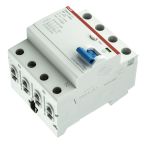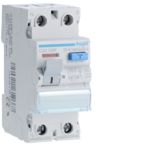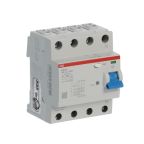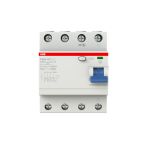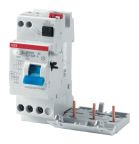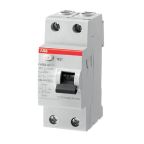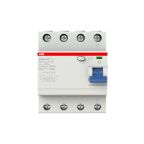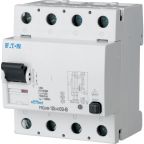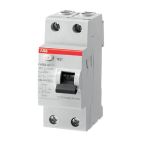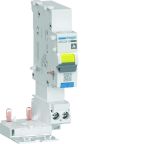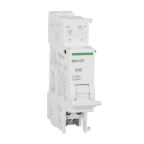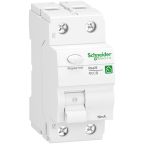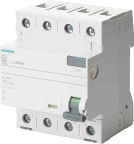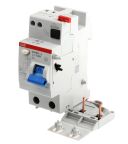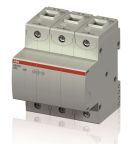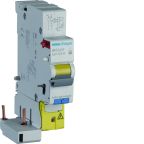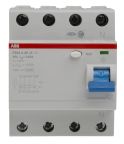RCCBs
An RCCB, or Residual Current Circuit Breaker, is a safety device designed to protect electrical circuits by preventing electric shocks and electrocution, as well as reducing the risk of electrical fires. These devices are essential in ensuring the safety of both residential and commercial electrical installations.
At RS, we offer an extensive range of high-performance RCCBs and RCDs from leading brands, including ABB, Schneider Electric, and Siemens.
How Does an RCCB Work?
An RCCB operates by monitoring the incoming and outgoing current in a circuit. For the device to function correctly, the incoming current must equal the outgoing current. RCCB breakers can compare the difference in current values between the live and neutral wires. Under normal conditions, all current entering an appliance through the live wire should exit via the neutral wire. If a fault occurs, such as a leakage current flowing through the earth wire or even through a person, the current will become unbalanced. This difference, known as residual current, triggers the RCCB to disconnect the circuit, thereby preventing potential harm.
What Is the Difference Between an RCCB and an RCD?
While the terms RCCB (Residual Current Circuit Breaker) and RCD (Residual Current Device) are often used interchangeably, there are key differences. An RCCB is a type of RCD that specifically detects residual currents but does not provide overload protection. RCDs, on the other hand, may include various types of devices that can also offer additional protection features. RCCBs are typically used in scenarios where the risk of electric shock is present but where overload protection is managed by separate devices.
What Are the Different Types of RCCBs?
RCCBs and RCDs are usually mounted on DIN rail. They can be 2, 3, or 4 poles. Varying in current ratings, trip sensitivity, and tripping characteristics. All these specifications should be carefully considered depending on your individual needs and application. Here’s an overview of the different types of RCCBs:
1. AC RCCB
Description: The AC RCCB is designed to detect leakage currents in alternating current (AC) circuits. It is the most common type used in residential and commercial installations.
Applications: Suitable for standard electrical appliances that do not contain electronic components, such as immersion heaters, incandescent lighting, and traditional electric showers.
2. Type A RCCB
Description: Type A RCCBs can detect both AC currents and pulsating direct currents (DC). This makes them suitable for applications involving electronic devices.
Applications: Ideal for circuits with electronic components, such as inverters, motor drives, and appliances with electronic controls.
3. Type F RCCB
Description: Type F RCCBs are designed to respond to composite residual currents, including pulsating DC superimposed on smooth DC currents. They can handle frequencies beyond the standard 50/60Hz.
Applications: Commonly used in variable frequency drives, washing machines, and other equipment that operate with variable frequency supplies.
4. Type B RCCB
Description: Type B RCCBs provide the broadest protection, detecting residual sinusoidal AC currents, pulsating DC currents, and smooth DC currents regardless of polarity. They can respond to frequencies up to 1 kHz.
Applications: Suitable for photovoltaic (PV) systems, electric vehicle charging stations, and industrial equipment that requires protection against all types of currents.
5. Pulsating DC RCCB
Description: Designed specifically to detect leakage currents in circuits with pulsating DC, these RCCBs are used in certain industrial applications.
Applications: Commonly found in power supplies for electronic equipment and specific industrial settings.
Considerations When Choosing an RCCB
When selecting an RCCB, consider the following factors:
- Current Rating: Choose an RCCB with a current rating that matches your circuit requirements.
- Tripping Sensitivity: Choose the appropriate sensitivity level (e.g., 10mA, 30mA, 100mA) based on the specific application and risk assessment.
- Number of Poles: Determine whether you need a 2-pole, 3-pole, or 4-pole RCCB based on the configuration of your electrical system.
- Environmental Conditions: Ensure the RCCB is suitable for the installation environment, particularly in outdoor or harsh conditions where moisture and dust may be present.
Industrial Applications of RCCB Circuit Breakers
RCCBs are crucial safety devices designed to protect against electrical hazards and fires. Their ability to detect and interrupt residual current makes them indispensable across various industries. Here are some key industrial applications:
- Construction: Construction sites present numerous electrical hazards due to exposure to the elements and heavy machinery. RCCB circuit breakers, often with higher current ratings like 60 AMP, safeguard workers from electrocution and prevent electrical fires, ensuring a safer work environment.
- Residential Buildings: 30mA RCCBs are commonly used in residential settings to protect against electric shocks in areas like bathrooms, kitchens, and outdoor installations. These devices offer crucial protection for families and their homes.
- Commercial Buildings: Commercial buildings require a higher level of electrical safety due to the increased number of occupants and complex electrical systems. A combination of 30mA and higher amperage RCCBs are used to protect both people and equipment, ensuring a safe working environment.
- Manufacturing Plants: Industrial facilities rely heavily on electrical power for machinery and equipment. RCCBs, particularly 2-pole RCCBs for single-phase applications, play a critical role in preventing electrical accidents and minimising downtime caused by electrical faults.
- Production Lines: Automated production lines require reliable protection against electrical hazards. RCCBs with appropriate trip sensitivities are used to safeguard sensitive equipment and prevent disruptions to the production process.
These are just a few examples of the many applications where RCCBs are used. RCCBs are essential components in any electrical installation, ensuring the safety of both people and equipment.
Frequently Asked Questions About RCCB Circuit Breakers
What are the advantages of using RCCB breakers?
An RCCB circuit breaker offers significant advantages in electrical safety. Primarily, it protects individuals from electric shock by quickly tripping the circuit in case of a current leakage to earth. This rapid response minimises the risk of serious injury or electrocution. Additionally, RCCBs safeguard against electrical fires caused by faulty equipment or wiring, thus preventing property damage and potential harm.
How to choose a residual current circuit breaker (RCCB)?
Choosing the right RCCB involves considering several factors. Firstly, determine the required current rating (e.g., 30A RCCB, RCCB 60 AMP) to handle the expected electrical load. Secondly, identify the appropriate number of poles (2-pole RCCB for single-phase, 4-pole for three-phase) based on your electrical system. Additionally, select the correct trip sensitivity (30mA RCCB for general protection) to suit your application. You can compare RCCB prices and features online to find the best fit for your needs.
What is the working principle of an RCCB circuit breaker?
An RCCB works on the principle of comparing the current flowing in the live and neutral wires of a circuit. Under normal conditions, the incoming current should equal the outgoing current. However, in case of a fault, some current may leak to earth, creating an imbalance. The RCCB senses this residual current and instantly trips the circuit, cutting off the power supply and preventing electrical shock or fire.
Why are residual current circuit breakers (RCCBs) used?
Residual current circuit breakers are used to provide essential safety in electrical installations. They protect against electric shock by detecting and interrupting residual currents, which can occur due to faulty equipment, damaged insulation, or accidental contact with live wires. Additionally, RCCBs help prevent electrical fires caused by current leakage, safeguarding property and lives.
How do you test and check your residual current circuit breaker (RCCB)?
Regular testing of your RCCB breaker is crucial to ensure its proper functioning. Most RCCBs have a built-in test button. Press the button to simulate a fault condition; the RCCB should trip immediately. If it doesn't, it may be faulty and requires replacement. If you're unsure about the testing procedure, consult a qualified electrician for assistance.
Remember, prioritising electrical safety is essential. If you have further questions or need help selecting the right RCCB for your needs, feel free to contact us. We are always available to provide expert advice and help you find the best solutions for your electrical installations.
Delivery Information
RS offers fast delivery of RCCB breakers and RCDs, including 2-pole, 30A, and 60 AMP options, along with essential accessories like DIN rail screw terminal blocks and mounting. For more details on delivery services and fees for circuit breakers, please refer to our Delivery page.
Related links
- Schneider Electric R9F RCCB 1 Pole Type A, 250V ac
- Copper Pipes
- Sensata Airpax Airpax Thermal Circuit Breaker - LELK111 3 Pole Panel Mount, 30A Current Rating
- Altech Thermal Circuit Breaker - V-EA 2 Pole 277V Voltage Rating DIN Rail Mount, 60A Current Rating
- Altech Thermal Circuit Breaker - V-EA 2 Pole 277V Voltage Rating DIN Rail Mount, 30A Current Rating
- Sensata Airpax Airpax Thermal Circuit Breaker - IUGN66 2 Pole Panel Mount, 30A Current Rating
- TE Connectivity Thermal Circuit Breaker - W92 2 Pole 277V ac Voltage Rating, 30A Current Rating
- Sensata Airpax Airpax Thermal Circuit Breaker - LELHK11 2 Pole Panel Mount, 30A Current Rating

